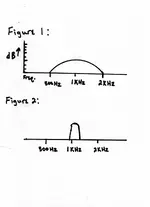Good explainations so far. I will try to add a little to it.
I am on a little kick of drawing stuff up and scanning it to illustrate what I am talking about. I am no "graphics artists" so work with me here and don't laugh at my drawings!

Filters, known as EQ's, can of course effect, and will, frequencies above and below the "center frequency". Your "center frequency" is that which you select with the Freq. knob on the EQ.
Bandwidth, or Q, is how far above and below the "center frequency" is effected. Wide (see Figure 1 on the provided .jpg) in this case is set to 2 octave. Notice though that with a 1KHz "center frequency", that 500Hz and 2KHz are NOT being turned up as much as 1KHz is. So, it is importent to remember that yes, all the frequencies in that 2 octave range are being effect, but the farther away from the "center frequency" you get, the less that frequency is effected. So, turning up 1KHz with a 2 octave bandwidth 6dB doesn't mean that everything between 500Hz and 2KHz is being turned up 6dB. In fact, 500Hz and 2KHz in this case might only be turned up about .1 dB.
Narrow (see Figure 2 on the provided .jpg) shows that again, 1KHz is being turned up (let's say 6dB). But notice that the bandwidth is very narrow, so 500Hz and 2KHz are not effected at all. Like stated earlier, this is very useful for isolating and effecting a certain frequency.
Use Wide to effect a broad band of frequencies (remembering that the farther away from the "center frequency" you get, the less it is effected) and Narrow to effect a limited frequecy. Which you decide, or anything in between is totally up to you in regards to what you expect to accomplish with the equalizer.
Good luck.
Ed


